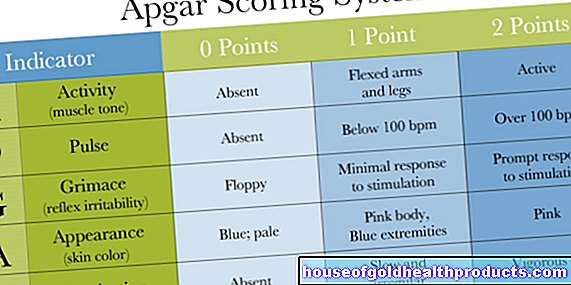Mindfulness exercises
All content is checked by medical journalists.Mindfulness exercises are exercises in which one trains conscious experience. They should help reduce stress. Since you usually do not need any aids, they can be easily integrated into everyday life. Here you will find specific instructions for mindfulness exercises and find out for whom mindfulness training is useful.

What are mindfulness exercises?
Mindfulness exercises are various techniques that train self-awareness and reduce stress. The aim is to develop a more open attitude and to experience the “here and now” more consciously. Mindfulness in this context means the willingness to accept what is without evaluating or avoiding feelings and thoughts. Mindfulness exercises are very important in Buddhism, for example in the form of mindfulness meditation.
Many people find it difficult to concentrate on doing the mindfulness exercises at the beginning - they first have to learn the principle of mindfulness.
There are different variations in mindfulness training. You can do the exercises on your own. In groups, a trainer usually takes on the guidance and leads the participants through the exercise.
When do you do mindfulness exercises?
Mindfulness therapy can be used as a supportive measure for various mental illnesses. Some therapists recommend mindfulness exercises for depression, depressive episodes, anxiety disorders, burnout and addictions. Some psychotherapeutic procedures also integrate mindfulness exercises, especially in the therapy of patients with borderline disorder (emotionally unstable personality disorder).
Mindfulness exercises for mental illnesses cannot replace medical or psychotherapeutic therapy. It is just a support.
Mindfulness-based stress reduction is also suitable for healthy people who experience a lot of stress in everyday life and want to reduce it a little. In principle, anyone can try out how to cope with stress through mindfulness - but it is important that you are open to the method and take the exercises seriously.
What do you do with mindfulness exercises?
There are several ways to practice mindfulness. Instructions for a few selected exercises can be found below.
Sitting quietly
Sitting still is a simple mindfulness exercise with breathing meditation that does not require any aids. Find a quiet place for this and take an upright posture - whether on a cushion on the floor, a chair or the sofa, it's up to you. Keep your eyes open and look straight ahead.
Now try to be aware of your breathing, for example by counting the inhalation and exhalation or mentally accompanying your breaths with “in” and “out”. Do not evaluate other thoughts that arise - let them pass and then return to conscious breathing meditation.
Do the exercise for at least eight minutes. Experienced people can also practice sitting quietly longer.
Walking meditation
Walking meditation comes from Zen Buddhism and is also known as Kinhin. It is often carried out after sitting meditations and is intended to loosen the joints again. Be sure to maintain the mindfulness gained in the previous exercise. Make yourself aware of the walking movement, feel your feet touch down and roll off.
The walking pace is individual, but usually you start with fast walking, which is slowed down after a few laps. You can place your hands relaxed on your body or on your back below your chest, with your head tilted slightly.
Perceiving and describing objects
These are mindfulness exercises for groups. They can be performed both sitting and standing.
The leader first hands out various simple items, for example stones, nuts or feathers. Each group member then has to describe his subject in his or her mind. You should give yourself enough time and mention small things or things that are taken for granted on the received object. Now you can also perceive the object consciously, for example by touching it blindly, being aware of how it feels on the skin, or smelling it.
Mental photography
This mindfulness exercise can be carried out particularly well in everyday life because it does not require any aids and only takes a few minutes. To do this, close your eyes and slowly move inside through the room or landscape. If you now open your eyes for a brief moment, imagine that you are photographing the moment with your eyes.
By focusing on the imaginary snapshots, this exercise is also suitable for breaking through stressful circles of thought and brooding. Mindfulness-based cognitive therapy therefore makes use of this exercise, for example, in the treatment of borderline patients.
Internal documentation and evaluation of what has been experienced
In this very simple exercise, you should take a mental step back in a situation you have just experienced and analyze your reaction to what you have experienced: Observe what you are feeling or thinking at that moment, how you evaluate which aspects and what this triggers in you.
Further information: Bodyscan
The body scan is used to improve body awareness. With its help, a better relationship between body and mind is to be learned and strengthened. How the Bodyscan works and when it is used can be read in the article Bodyscan.
What are the risks of mindfulness exercises?
Mindfulness exercises are not a medical intervention. The exercises themselves are completely risk-free. Mentally ill patients, however, can sometimes be overwhelmed with the implementation, so that guidance from a therapist makes sense for them, at least at the beginning.
What do I have to consider after mindfulness exercises?
The mindfulness exercises, if you practice them regularly and seriously, can help you relax and reduce stress. Try to hold onto the conscious experience gained during training in order to achieve the greatest possible effect.
Tags: sports fitness Menstruation eyes





























